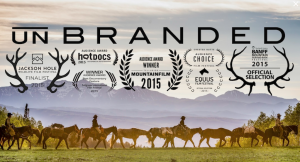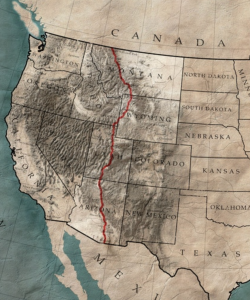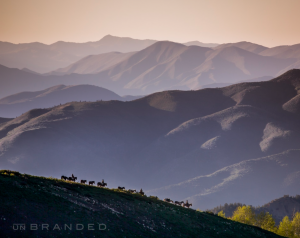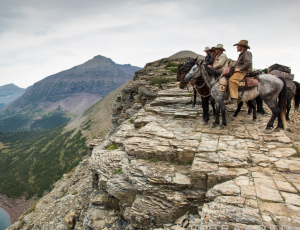Editor’s Note: Unbranded is the documentary film about the epic, 3,000-mile journey of four Texas A & M University grads and their cavvy of extraordinary mustangs. It has won numerous film festival awards. Watch trailer here.
Cayuse Communications was the only media outlet interviewing the team during their journey. We have the most extensive catalog of Unbranded features, topping all other publications by dozens of pages.
 Coming up, we will have more interviews with producer Dennis Aig, director Phill Baribeau, editor Scott Chestnut, and many more.
Coming up, we will have more interviews with producer Dennis Aig, director Phill Baribeau, editor Scott Chestnut, and many more.
Part Three of this multi-part interview series:
Unbranded isn’t all about horses. There’s a strong message of conservation and access to public lands, too.
Says Ben Masters in this Kickstarter video:”There’s not enough room out there for the wild horses and sometimes I feel like there’s not a lot of room out there for us either…I think we’re saving each other by doing this long trip. We’re getting them out of their captivity and they’re helping us get out of ours.”
Our interview with Unbranded’s Masters continues as they head into Yellowstone National Park:
Maddy Butcher: We’ve noticed Unbranded has a strong message of conservation and public open space.
 Ben Masters: Yeah absolutely. There’s 773 million acres of public space in the United States and I don’t think a lot of people realize it’s there and ours to use. So almost our entire route, from Mexico to Canada, is a patchwork of BLM, national forests, national parks, wilderness areas. I think it’s pretty incredible that there’s a corridor of public land with almost no fences all the way from Mexico to Canada, and that you can still do a trip like this on.
Ben Masters: Yeah absolutely. There’s 773 million acres of public space in the United States and I don’t think a lot of people realize it’s there and ours to use. So almost our entire route, from Mexico to Canada, is a patchwork of BLM, national forests, national parks, wilderness areas. I think it’s pretty incredible that there’s a corridor of public land with almost no fences all the way from Mexico to Canada, and that you can still do a trip like this on.
MB: I noticed you all are carrying guns? Is that for grizzlies or something else?
BM: That’s to kill a horse if it breaks a leg.
MB: Have you ever had to do that?
BM: No. Hopefully, we’ll never have to pull those pistol triggers.
MB: You already have a strong fan base. Have there been any liabilities associated with the advanced promotion?
BM: No, we haven’t had any crazy stalkers come out to try to hunt us down or anything like that. We haven’t had any negatives. Only positives.
MB: You took a similar trip with two friends in 2010. Can you tell me a bit about it?
 BM: We started with six horses. The common theme with that trip is that the mustangs outperformed the quarterhorses. We had to replenish the quarterhorses whereas the mustangs went the entire way. That’s why we’re trying to use mustangs this trip.
BM: We started with six horses. The common theme with that trip is that the mustangs outperformed the quarterhorses. We had to replenish the quarterhorses whereas the mustangs went the entire way. That’s why we’re trying to use mustangs this trip.
It took four and a half months. And it loosely followed the Continental Divide. We followed the Continental Divide trail from Santa Fe to the Canadian border.
MB: You often mention nice meals when you occasionally reach towns. How are you hanging in there with camp meals?
BM: We resupply food every 10 days or so. Before the trip started we prepackaged food boxes that had everything we needed and then our mothers sent us those food packages so we could pick them up. That way we would not have to go shopping.
MB: What’s a typical day’s menu?
BM: We eat trail mix bars and candy and that kind of thing all day and then we just have one big dinner. Usually, it consists of pasta and canned foods and then we have some dried foods, too. Astronaut food kind of stuff.
MB: How about jerky?
BM: We eat a lot of jerky.
MB: It’s sounds similar to backpacking.
 BM: Exactly.
BM: Exactly.
MB: You’re heading out of cellular phone service now?
BM: Correct. We’re about to go through the Teton Wilderness, Yellowstone Park, Gallatin National Forest, Beaverhead-Deerlodge National Forest.. We’ll be out of cell phone range until August.
MB: So if something bad happens, what’s your contingency plan?
BM: We have a satellite phone and we also have an emergency beacon where you hit the red button and a helicopter comes in and brings you out.
MB: I was studying the route and your time and mileage. The route planning seems like an incredible logistical feat.
BM: Thank you.
MB: I imagine it took a lot of time.
BM: You have no idea. There are so many things to take into consideration: The elevation. The time of year. The grade and condition of the elevation at that time of the year. Water availability.
There’s a lot of thought that went into planning the route. Realistically, it took about a year or so. I don’t know how many hundreds of hours.
It’s paid off. The route’s been good to us. We haven’t had too many mishaps.
PHOTO CREDITS: Ben Masters and Unbranded